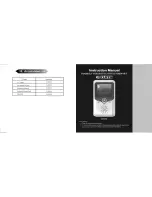
7
SECTION 4
INSTALLATION - PART 1
4.1 LIFTING
Warning!
Four lifting lugs are provided for use with a shackle and pin
type lifting aid in conjunction with a spreader bar. Chains of
suitable length and lifting capacity must be used. Care is
therefore needed to avoid personal injury or equipment
damage. Correct lifting arrangement is shown on the label
attached to a lifting eye. A typical label is shown below.
Single bearing generators are supplied with the rotor
clamped to the stator frame with a transit strap to prevent
axial movement of the rotor and two shaft support brackets
have been fitted which support the rotor through the fan.
Once this strap is removed and the support bracket, to
couple the rotor to the engine, the rotor is free to move in the
frame, and care is needed during coupling and alignment to
ensure the frame is kept in the horizontal plane.
4.2 ASSEMBLY TO ENGINE
4.2.1 TWO BEARING MACHINES
A flexible coupling should be fitted and aligned in
accordance with the coupling manufacturer's instruction.
If a close coupling adaptor is used the alignment of
machined faces must be checked by offering the generator
up to the engine. Shim the generator feet if necessary.
Ensure adaptor guards are fitted after generator/engine
assembly is complete.
Open coupled sets require a suitable guard, to be provided
by the set builder.
Caution !
Incorrect guarding and/or generator
alignment can result in personal
Injury and/or equipment damage.
4.2.2 SINGLE BEARING MACHINES
4.2.2.1
INSTALLATION
All generators are transported from the factory with a shaft-
locking strap fitted across the outside of the fan housing.
Premature removal of this strap will result in damage to the
rotor field excitor, fitted inboard of the non-drive end bearing.
So that the locking strap can be safely removed, two shaft
support brackets have been fitted which support the rotor
through the fan. It is inessential that that the support strip is
removed before the machine is run.
Before removing the strap and support brackets the
following steps must be followed:
1.
Once the Alternator is on site and positioned closely to
its final position, remove the shaft locking strap fitted
across the front of the shaft.
2. Couple the alternator to the engine. Note - the rotor
support brackets have not been designed so that the
alternator can not be barred over. The engine should be
bared over instead.
3. It is only safe to remove the support brackets when all
the engine/alternator-coupling bolts have been fully
tightened. This done by removing the bolt in each
support bracket and pulling it forward to clear the fan.
Finally withdraw it through the side opening.
4.2.2.2
ALIGNMENT
Alignment of single bearing generators is critical. If
necessary shim the generator feet to ensure alignment of the
machined surfaces.
The sequence of assembly to the engine should generally be
as follows:
1.
On the engine check the distance from the coupling
mating face on the flywheel to the flywheel housing
mating face. This should be within 0.5mm of nominal
dimension. This is necessary to ensure that a thrust is
not applied to the AC generator bearing or engine
bearing.
2.
Check that the bolts securing the flexible plates
to the Coupling hub are tight and locked into position.
For tightening torque refer to section 7 table H.
3.
Remove covers from the drive end of the generator to
gain access to coupling and adaptor bolts.
4. Check
that
coupling
discs
are concentric with adaptor
spigot. This can be adjusted by the use of tapered
wedges between the fan and adaptor.
Alternatively the rotor can be suspended by means of
a rope sling through the adaptor opening.
Incorrect lifting of inadequate lifting
capacity can result in severe personal
injury of equipment damage. Lifting
capacity required for complete generator
is 7 tonnes. See data sheets for weights
of individual lifts. Generator lifting lugs
should not be used for lifting the complete
generating set.







































